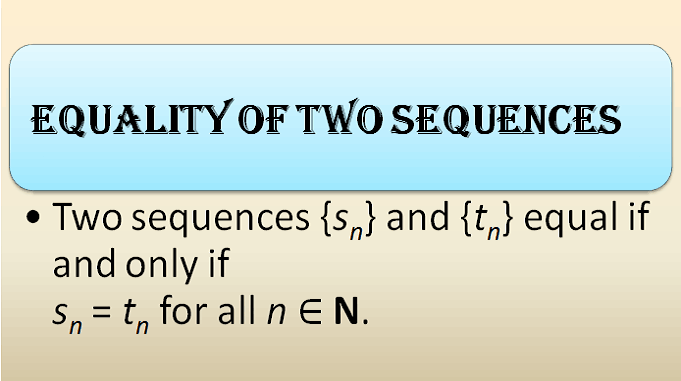
Basic Operations on Sequences:
Here, we will introduce the basic operations for sequences. We know that the operations of addition, subtraction, multiplication, and division can all be defined using real numbers. These operations can easily be applied to a set of sequences. These operations are extended in a term-by-term manner. Let’s look at the definitions for each operation on sequences.
Basic Operations on Sequences:
Let {sn} and {tn} be two sequences.
1. Addition of Sequences:
The sequence having nth terms is called the sum (addition) of the sequences {sn} and {tn}, and it is denoted by {
}. That is,
.
2. Difference of Sequences:
The sequence having nth terms is called the difference of the sequences {sn} and {tn}, and it is denoted by {
}. That is,
.
3. Multiplication of Sequences:
The sequence having nth terms is called the product (multiplication) of the sequences {sn} and {tn}, and it is denoted by {
}. That is,
.
4. Reciprocal of the Sequence:
If for all n∈N, then the sequence having nth terms
is called the reciprocal of the sequence
, and it is denoted by {
}.
5. Division of Sequences:
The sequence having nth terms is called the division of the sequences {sn} and {tn}, and it is denoted by {
}. That is,
.
6. Scalar Multiplication of a Sequence:
If c∈R, then the sequence having nth terms is called the scalar multiple of the sequence
, and it is denoted by {
}. That is,
.
अनुक्रमों पर मूल संक्रियाएं (Basic Operations on Sequences):
यहां, हम अनुक्रमों के लिए मूल संक्रियाओं (basic operations) का परिचय देंगे। हम जानते हैं कि वास्तविक संख्याओं का उपयोग करके जोड़, घटाव, गुणा और भाग सभी को परिभाषित किया जा सकता है। इन संक्रियाओं को आसानी से अनुक्रमों के एक समुच्चय पर लागू किया जा सकता है। इन संक्रियाओं को टर्म-बाय-टर्म (term-by-term) तरीके से विस्तारित किया जाता है। आइए, अनुक्रमों पर प्रत्येक संक्रिया की परिभाषाओं को देखें।
अनुक्रमों पर मूल संक्रियाएं (Basic Operations on Sequences):
मान लीजिए {sn} और {tn} दो अनुक्रम हैं।
1. अनुक्रमों का जोड़ (Addition of Sequences):
nवें पदों वाले अनुक्रम को अनुक्रमों {sn} और {tn} का योग (जोड़) कहा जाता है, और इसे {
} द्वारा दर्शाया जाता है। अर्थात्,
.
2. अनुक्रमों का अंतर (Difference of Sequences):
nवें पदों वाले अनुक्रम को अनुक्रमों {sn} और {tn} का अंतर (घटाव) कहा जाता है, और इसे {
} द्वारा दर्शाया जाता है। अर्थात्,
.
3. अनुक्रमों का गुणन (Multiplication of Sequences):
nवें पदों वाले अनुक्रम को अनुक्रमों {sn} और {tn} का गुणनफल (गुणा) कहा जाता है, और इसे {
} द्वारा दर्शाया जाता है। अर्थात्,
.
4. अनुक्रम का व्युत्क्रम या गुणन प्रतिलोम (Reciprocal of the Sequence):
यदि सभी n∈N के लिए , तो nवें पदों वाले अनुक्रम
को अनुक्रम
का व्युत्क्रम कहा जाता है, और इसे {
} द्वारा दर्शाया जाता है।
5. अनुक्रमों का विभाजन (Division of Sequences):
nवें पदों वाले अनुक्रम को अनुक्रमों {sn} और {tn} का विभाजन (भाग) कहा जाता है, और इसे {
} द्वारा दर्शाया जाता है। अर्थात्,
.
6. अनुक्रम का अदिश गुणन (Scalar Multiplication of a Sequence):
यदि c ∈ R, तो nवें पदों वाले अनुक्रम को अनुक्रम
का अदिश गुणज कहा जाता है, और इसे {
} द्वारा दर्शाया जाता है। अर्थात्,
.
Copyrighted Material © 2019 - 2024 Prinsli.com - All rights reserved
All content on this website is copyrighted. It is prohibited to copy, publish or distribute the content and images of this website through any website, book, newspaper, software, videos, YouTube Channel or any other medium without written permission. You are not authorized to alter, obscure or remove any proprietary information, copyright or logo from this Website in any way. If any of these rules are violated, it will be strongly protested and legal action will be taken.



Be the first to comment